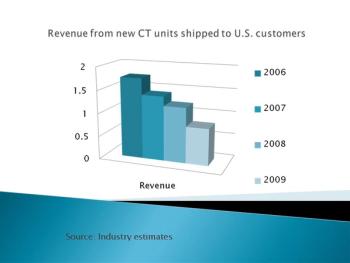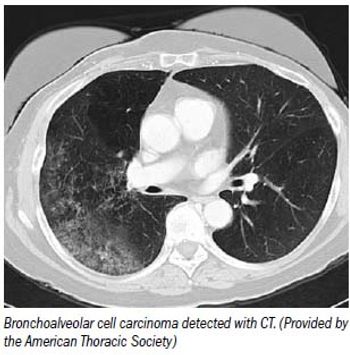
PET/CT imaging with FDG can identify when a tear in the wall of the aorta causes blood to flow between the wall's layers and forces the layers apart, according to research.

PET/CT imaging with FDG can identify when a tear in the wall of the aorta causes blood to flow between the wall's layers and forces the layers apart, according to research.

In the wake of the slice wars, which saw CT scanners boom from four to 320 slices, a new battle will be fought, one focused on energy and spectral imaging. Photon counting, triple- and quad-energy systems, and a new breed of contrast agents are emerging drivers in the development of spectral CT, say some experts in topics scheduled for the Tuesday, May 18, ISCT session on Dual Energy and Spectral Imaging.

A dramatic shift in R&D toward patient safety has taken place in the CT industry, a shift most clearly seen in efforts to reduce patient radiation dose. Iterative reconstruction algorithms are a prominent fixture at the ISCT meeting this year, as they and their future development are increasingly seen as providing the means to cut dose, while maintaining or even boosting image quality.

Fears that revenues last year from the sale of new CTs in the U.S. would slide to levels not seen in a long time proved to be well founded, as the industry suffered its worst year in more than a decade.

The laws of physics cannot be broken-but they can be bent.

Much is known about dose reduction and adult patients, but what about kids? The literature is scant, but that doesn’t mean solutions don’t exist, according to a presenter at the International Society for Computed Tomography conference May 21.

Radiologists have come to expect rising demand for CT, which is why anecdotal reports of sudden and dramatic falls in CT volumes have sent a shudder through the community. All the more alarming is that the rumored drop-offs are coming at the request of patients who want nothing to do with CT because they fear its radiation will someday cause cancer. Instead they reportedly are demanding ultrasound or MRI because neither has ionizing radiation -- never mind that neither is indicated, nor, particularly in the case of ultrasound, has much chance of providing useful information.

Efforts to interconnect information systems raise the possibility that different experiences from multiple sites might be pooled and the practice of medicine made better through a kind of collective wisdom. At the ISCT symposium, Sandy Napel, Ph.D., a Stanford professor of radiology and codirector of the Radiology 3D Laboratory, examined how diagnoses made on some patients might help clarify whether the same diagnoses apply to others.

Iterative reconstruction algorithms will have a “profound effect” on CT as the enabling technology for advances in image quality and patient safety, said Stanford radiology professor Geoffrey Rubin at the ISCT symposium on multidetector row CT.

Clinical studies examining the potential of CT exposure to cause cancer are under way, but it could be years or even a decade until the results are known. Even then, they may be inconclusive, say expert presenters at the ISCT symposium on MDCT.

While most physicians rely on serum creatinine levels to determine kidney function, it’s not the most reliable indicator, according to a nephrologist who presented at the International Society for Computed Tomography on May 18. Instead, he suggested providers look at the estimated glomerular filtration rate (eGFR). In acutely ill patients in particular look at the changing serum creatinine (sCR) levels and not the specific values or specific eGFRs, he said.

GE Healthcare jumped ahead of competitors in the race to cut patient dose with the commercial release in 2008 of its Adaptive Statistical Iterative Reconstruction (ASIR), the first software to clean up CT images and, in the process, allow dramatic reductions -- up to 50% -- in patient radiation dose. In the first day of this year’s ISCT symposium, iterative reconstruction was hailed repeatedly as the leading solution to the hottest issue in CT patient safety.

TeraRecon’s “iNtuition Cloud” debuted as a commercially available product May 18 at the ISCT symposium. The newly available system is the company’s flagship iNutition solution in “Software as a Service” form.

While some may ask whether the CT community should transition to low kV, Willi A. Kalender, Ph.D., a professor in the Institute of Medical Physics at the University of Erlangen, in Germany, asks why not.

Three-D is all the buzz, as PACS companies struggle to include it in their products, if they haven’t already. But where this form of advanced visualization fits into the diagnostic process is still up in the air. Ironically, so are some of the everyday tools on which advanced visualization depends. Trust issues about the automation that makes sophisticated postprocessing viable are beginning to surface, just as progress in CAD offers new clinical capabilities.

What do you get when you mix contrast delivery with computer technology? Dr. Dominik Fleischmann, director of CT at Stanford Hospital and Clinics kicks off a session at the International Society for Computed Tomography conference starting May 18 on contrast medium delivery and image enhancement. He will focus on how power injectors are starting to act as computers.

In the wake of the slice wars, which saw CT scanners boom from four to 320 slices, a new battle will be fought, one focused on energy and spectral imaging. Photon counting, triple- and quad-energy systems, and a new breed of contrast agents are emerging drivers in the development of spectral CT, say some experts in topics scheduled for the Tuesday, May 18, ISCT session on Dual Energy and Spectral Imaging.

A commonly used probe for PET scanning and a new probe developed by researchers at UCLA reveal different functions in diverse cells of the immune system, providing a much clearer picture of an immune response in action.

A dramatic shift in R&D toward patient safety has taken place in the CT industry, a shift most clearly seen in efforts to reduce patient radiation dose. Iterative reconstruction algorithms are a prominent fixture at the ISCT meeting this year, as they and their future development are increasingly seen as providing the means to cut dose, while maintaining or even boosting image quality.

Fears that revenues last year from the sale of new CTs in the U.S. would slide to levels not seen in a long time proved to be well founded, as the industry suffered its worst year in more than a decade.

The last decade-plus has seen unprecedented development in all aspects of CT technology. Presenters will kick off the International Society for Computed Tomography symposium Tuesday morning May 18 looking at this evolution as part of the “Technology: Present and Future” session.

The world of medical imaging will miss Linda Clarkson, who passed away unexpectedly in March.

Using high-resolution CT scans to screen for lymphangioleiomyomatosis is cost-effective in women between the ages of 25 and 54 who don’t smoke and come to the emergency room for the first time with a collapsed lung, according to University of Cincinnati researchers.

Reduced or no “padding” during ECG-triggered coronary CT angiography results in a substantial reduction in radiation dose without affecting image quality and interpretability, according to a study in the April American Journal of Roentgenology.

A study finding relatively high false-positive rates for CT screening of lung cancer will probably not be the definitive word on the subject.